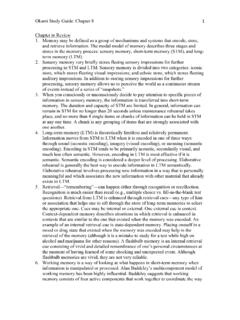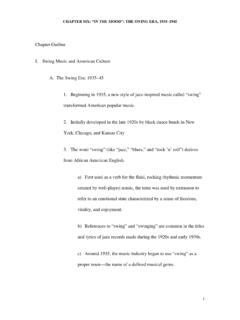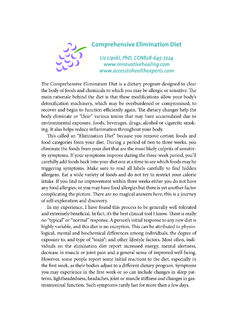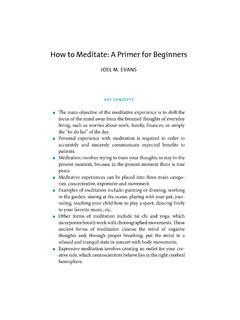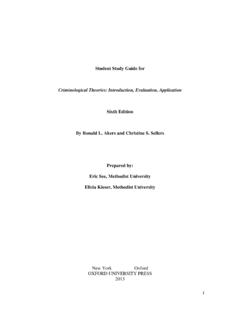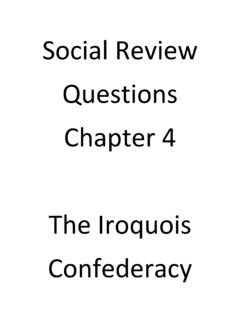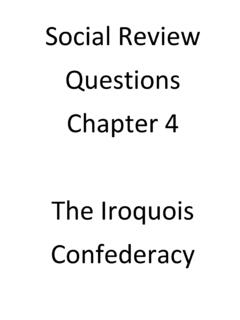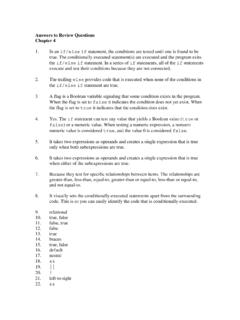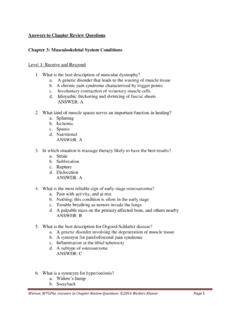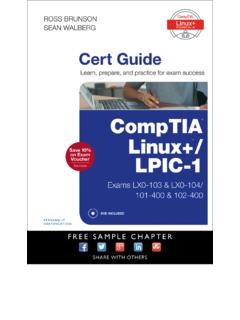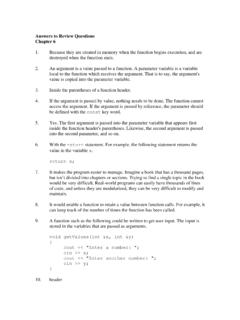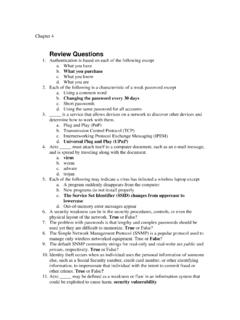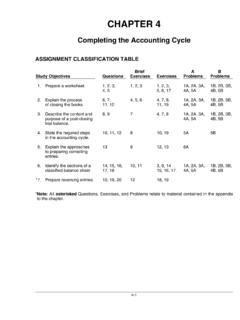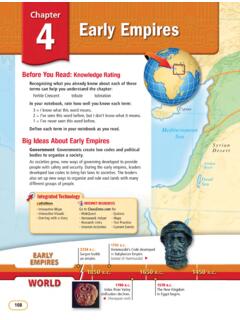Transcription of Appendix B: Review Questions - global.oup.com
1 Appendix B: Review Questions chapter 1: Answers to Review Questions Your answers should include the following points: 1. Re-examine the Scenarios laid out in the Self-Assessment exercise and determine the qualities, advantages, and benefits of each option. There are situations where text and Twitter is inappropriate, places where restraint and self-editing is justified, and a circumstance where privacy boundaries must be respected. There is one scenario where future income hinges on the correct decision. Reread the text and make your selections based on the guidance and content of the material. 2. The definition of human communication and the characteristics it embodies establishes the foundation of this textbook. Review chapter 1 extensively. 3. Not all mediated communication is intended for mass audiences. The similarity with face-to-face is equivalent to whispering, using your indoor voice, or shouting at a football game.
2 The sender decides the message and the receiver. Review the components dealing with mediated versus face-to-face communication and the section titled Understanding Social Media. The differences occur in three ways. Have you experienced this in personal situations? 4. Each type is used by communicators on a daily basis. You should be prepared to give examples. See the section of this chapter titled Types of Communication. 5. Review the component in this chapter titled Functions of Communication. 6. Communication competence is vital to success and completion of your daily functions. The Self-Assessment chart in chapter 1 dealing with Communication Competence is a nice evaluation of your strengths and goals. This chart gives you a starting place to measure your traits and tendencies when expressing yourself in a dispute, conflict, or difference of opinion.
3 7. Does your diagram indicate that both sending and receiving are simultaneous? How important is feedback? Can you describe the noise interfering with the effective sending and receiving of messages? Go back to chapter 1 in the text and Review Figure 1-2. 8. Combining the definition of dyadic communication found in chapter 1 by Photo 1-5 and then combining the Calvin & Hobbes cartoon regarding self-monitoring; describe how you/why you decided to shape your behavior. chapter 2: Answers to Review Questions Your answers should include the following points: 1. Review the beginning of this chapter and the discussion of Communication and the Self. Who are you? Make this personal. Identify what affects your self-concept. 2. The definition of self-concept, as described in chapter 2, reflects how we see our self and our interpretation of how others perceive us.
4 Common characteristics usually cited begin with (but in no way are limited to) age, gender, ethnicity, regional identification, height, weight, religion, and physical attributes. 3. Expectations and assumptions frequently skew the outcome ahead of time. Look at the material covered in Figure 2-1 of this chapter . 4. Review the Common Perceptual Tendencies identified in chapter 2. 5. Empathy, Perception, and Communication in chapter 2 explains the process of empathy application. 6. Refer to the explanations in chapter 2 that deal with Characteristics of Identity Management. 7. See the element of chapter 2 pertaining to Identity Management in Mediated Communication. 8. The instant reaction tends to be to answer yes, but there are sensitive and ethical challenges to identity management and honesty. Weigh carefully the judicial balance of how far is too far, how honest is too honest.
5 chapter 3: Answers to Review Questions Your answers should include the following points: 1. Culture and coculture influence everyone s methods of communication. Cultures and cocultures mingle in the classroom, grocery store, entertainment field, and employment choices. Answers will vary, but the first six pages of this chapter should clarify your answer. 2. The meanings of phrases using the same language but with various connotations, the interpretation of nonverbal signals, the frequency or lack thereof of vocal intonations, even the concept of self-centeredness or being a team player. What you are used to is correct and acceptable; what is different is unsettling and suspicious. There are daily examples of this you should be able to enumerate. 3. Stereotypical thinking and preconceived assumptions often blur the distinction between actual cultural differences and overgeneralizations.
6 A native of Alabama and a working-class resident of New Jersey; a native Texan and an immigrant from India; a teenager from California and a senior citizen from Idaho .. do you stereotype and overgeneralize? Check the section of this chapter dealing with Cultural Values and Norms. 4. Compare and contrast individuals in the same age group, with shared ethnicity, identical education, and fairly uniform socioeconomic status with the communication traits of a vastly dissimilar group. What norms, traits, values, and concepts are different? Which group does it right ? Take the Intercultural Sensitivity Self-Assessment in this chapter . 5. Codes, verbal and nonverbal, and how they are used in cultures vary depending on many influences. You should have an appreciation of the challenges that arise with people from different cultures/cocultures seeking to communicate.
7 Examine the section of this chapter that addresses Codes and Culture. 6. How open-minded are you? How sensitive are you to other cultures? Take the Intercultural Sensitivity Self-Assessment. Be honest in your answers. Could you improve your intercultural communication competence? Cite specific examples of what you can do regarding the cultures/cocultures around you in your daily life. 7. While interacting successfully with strangers calls for the same basic ingredients of general communication competence outlined in chapter 1, this chapter highlights unique elements for Developing Intercultural Communication Competence. 8. Descriptions and examples may vary but they should be in line with Table 3-2 of this chapter . chapter 4: Answers to Review Questions Your answers should include the following points: 1.
8 The rules of language come with challenges. When there are rules, there are exceptions. Still, the early part of chapter 4 identifies the rules and gives multiple examples of their applications. 2. See the examples cited in the text regarding names, credibility, status, sexism, and racism. 3. Besides shaping the way we view our self and indicating inner thoughts, sometimes unconsciously, the way we use language causes others to form opinions about us. The emotion or power behind our words, the connection with our home or workplace, our likes and dislikes, and our willingness to accept responsibility is an everyday indicator of who we are. Table 4-1 in this chapter and examples from the text that follows explain this in greater detail. 4. While cultural and cocultural differences do exist, causing statements to be misunderstood, too often the sender is either not precise enough or is deliberately vague.
9 Review the section in chapter 4 dealing with Troublesome Language. 5. The four linguistic acrobatic tricks used to accept and/or reject responsibility are detailed in chapter 4. 6. Cartoon 4-6 in chapter 4 highlights the challenges of he said/she heard and she said/he heard. 7. There is no right or wrong on the Self-Assessment rubric. It is designed to enlighten and educate. chapter 5: Answers to Review Questions Your answers should include the following points: 1. While it must be established early that listening and hearing are not the same thing, it is also import to clarify, with examples, the stages of listening as opposed to hearing. This should also include the contrast between mindful versus mindless listening. 2. It seems apparent that listening ability declines with age. Adults need to be aware of the challenges, some of which are their own fault, hampering effective listening.
10 Examples should include the faulty listening behaviors and personal experiences. This section of chapter 5 highlights and underlines the faulty listening behaviors with succinct explanations. 3. Care should be taken to separate the faulty listening behaviors from the reasons for poor listening. The first are conscious obstacles dealing with mindset and attitude; the latter often are unconscious attributes requiring more self-awareness strategies of the process taking place. Review the @Work Box on multitasking in this chapter and follow up with the many reasons for poor listening. 4. This is designed to help discover listening tendencies. There is no right or wrong; it simply reflects your experiences and goals. 5. Where the advantages of task-oriented listening assist in organization and efficiency, some people are too preoccupied to be aware of the process.
